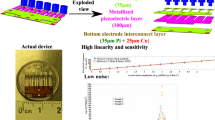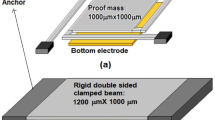Abstract
We present the miniaturization limits of axially loaded piezoresistive MEMS accelerometers. Therefore we identify limiting factors on the basis of FEM-verified analytical models. To ensure a broad discussion we compare two different axially loaded topologies: first a conventional topology, which can be manufactured already today, and second a future-oriented topology utilizing nanowires. To enable a realistic comparison of the different topologies we shrink the sensor while maintaining a specific performance (e.g. sensitivity and noise) considering design limitations such as fracture of silicon and buckling. To find the minimum total sensor area under certain constraints and therefore the optimal geometric and material parameters we apply optimization techniques to our analytical models. It will be seen that the piezoresistive transducer principle for MEMS accelerometers has a promising shrink potential with minimum total sensor dimensions as low as 150 × 150 × 10 μm3 achievable by use of currently available manufacturing processes.

















Similar content being viewed by others
References
Amarasinghe R, Dao DV, Toriyama T, Sugiyama S (2007) Development of miniaturized 6-axis accelerometer utilizing piezoresistive sensing elements. J Sens Actuators A Phys 134:310–320
Bao MH (2000) Handbook of sensors and actuators, volume 8: micro mechanical transducers. Elsevier, Amsterdam. ISBN 0-444-50558-X
Boroch R, Wiaranowski J, Mueller-Fiedler R, Ebert M, Bagdahn J (2006) Characterization of strength properties of thin polycrystalline silicon films for MEMS applications. Fatigue Fracture Eng Mater Struct 30:2–12
Bosch Sensortec GmbH (2008) Data sheet BMA150 Digital, triaxial acceleration sensor. http://www.bosch-sensortec.com
Chen H, Bao M, Zhu H, Shen S (1997) A piezoresistive accelerometer with a novel vertical beam structure. J Sens Actuators Phys A 63:19–25
Chen S, Xue C, Zhang W, Xiong J, Zhang B, Hu J (2008) A new type of MEMS two axis accelerometer based on Silicon. Proc Nano/Micro Eng Mol Syst 3:959–964
Dao DV, Toriyama T, Sugiyama S (2004) Noise and frequency analyses of a miniaturized 3-DOF accelerometer utilizing silicon nanowire piezoresistors. Proc IEEE Sens 3:1464–1467
Dong P, Wu X, Li S (2007) A high-performance monolithic triaxial high-g accelerometer. Proceedings of IEEE Sensors Conference, pp 768–771
Engesser M, Franke AR, Maute M, Meisel DC, Korvink JG (2009) An optimization technique for area shrinking problems applied to MEMS accelerometers. Proceedings Smart Systems Integration, pp 111–118. ISBN 978-3-89838-616-6
Gonzales P, Severi S, Lenci S, Merken P, Witvrouw A, Meyer KD (2008) Evaluation of piezoresistivity and 1/f noise of polycrystalline SiGe for MEMS sensor application. Proc Eurosens XXII:881–884
Harley JA (2000) Advances in piezoresistive probes for atomic force microscopy. Dissertation at the department of Mechanical Engineering, Stanford University
Harley JA, Kenny TW (2000) 1/f noise considerations for the design and process optimization of piezoresistive cantilevers. J Microelectromech Syst 9:226–235
Hitachi Metals Ltd. (2008) Data sheet H34C 3-Axis Accelerometer with IC. http://www.hitachimetals.com/
Hooge FN (1969) 1/F noise is no surface effect. J Phy Lett 29:139–140
Huang S, Li X, Wang Y, Jiao J, Ge X, Lu D, Che L, Zhang K, Xiong B (2003) A piezoresistive accelerometer with axially stressed tiny beams for both much increased sensitivity and much broadened frequency bandwidth. Conference on Solid State Sensors, Actuators and Microsystems 12:91–94
Kanda Y (1982) A graphical representation of the piezoresistance coefficients of silicon. IEEE Trans Electron Devices 29:64–70
Kruglick EJJ, Warneke BA, Pister KSJ (1998) CMOS 3-axis accelerometers with integrated amplifier. Proc Micro Electro Mech Syst 11:631–636
Mimosa (2006) http://www.mimosa-fp6.com
Minami (2008) http://www.fp6-minami.org
Okamura A, Dao DV, Toriyama T, Sugiyama S (2005) Fabrication of an ultra small accelerometer utilizing Si nanowire piezoresistors. Proc Sens Symp 22:203–206
Park WT, Partridge A, Candler RN, Ayanoor-Vitikkate V, Yama G, Lutz M, Kenny TW (2006) Encapsulated submillimeter piezoresistive accelerometers. J Microelectromech Syst 15:507–514
Partridge A, Reynolds JK, Chui BW, Chow EM, Fitzgerald AM, Zhang L, Maluf NI, Kenny TW (2000) A high-performance planar piezoresistive accelerometer. J Microelectromech Syst 9:58–66
Roylance LM, Angell JB (1979) A batch-fabricated silicon accelerometer. IEEE Trans Electron Devices 12:1911–1917
Sandmaier H, Kuehl K, Obermeier E (1987) A silicon based microelectromechanical accelerometer with cross acceleration sensitivity compensation. Proc Transducers 4:399–402
Sankar AR, Das S, Lahiri SK (2008) Cross-axis sensitivity reduction of a silicon MEMS piezoresistive accelerometer. J Microsyst Technol 15:511–518
Smith CS (1954) Piezoresistance effect in germanium and silicon. Phys Rev 94:42–49
Spengen WM, Bakker E, Frenken JWM (2007) A ’nano-battering ram’ for measuring surface forces: obtaining force–distance curves and sidewall stiction data with a MEMS device. J Miromech Microeng 17:91–97
Tacano M, Pavelka J, Tanuma N, Yokokura S, Hashiguchi S (2004) Dependence of Hooge constant on mean free paths of materials. Proc SPIE 5469:310–319
Takao H, Fukumoto H, Ishida M (2001) A CMOS integrated three-axis accelerometer fabricated with commercial submicrometer CMOS technology and bulk-micromachining. IEEE Trans Electron Devices 48:1961–1968
Thurber WR, Mattis RL, Liu YM, Filliben JJ (1980) Resistivity-dopant density relationship for boron-doped silicon. J Solid State Sci Tech 127:2291–2294
Timpe SJ, Komvopoulos K (2005) An experimental study of sidewall adhesion in microelectromechanical systems. J Microelectromech Syst 14:1356–1363
Toriyama T, Tanimoto Y, Sugiyama S (2002) Single crystal silicon nano-wire piezoresistors for mechanical sensors. J Microelectromech Syst 11:605–611
Tran TD, Dao DV, Bui TT, Nguyen LT, Nguyen TP, Susumu S (2008) Optimum design considerations for a 3-DOF micro accelerometer using nanoscale piezoresistors. Proceedings of the 3rd IEEE International Conference on Nano/Micro Engineered and Molecular Systems, pp 770–773
Vandamme LKJ, Oosterhoff S (1986) Annealing of ion-implanted resistors reduces the 1/f noise. J Appl Phys 59:3169–3174
Wang Z, Yue R, Zhang R, Liu L (2005) Design and optimization of laminated piezoresistive microcantilever sensors. J Sens Actuators A Phys 120:325–336
Warneke B, Hoffman E, Pister KSJ (1995) Monolithic multiple axis accelerometer design in standard CMOS. Proc SPIE 2642:95–102
Author information
Authors and Affiliations
Corresponding author
Rights and permissions
About this article
Cite this article
Engesser, M., Franke, A.R., Maute, M. et al. Miniaturization limits of piezoresistive MEMS accelerometers. Microsyst Technol 15, 1835–1844 (2009). https://doi.org/10.1007/s00542-009-0920-4
Received:
Accepted:
Published:
Issue Date:
DOI: https://doi.org/10.1007/s00542-009-0920-4




